|
Report
from
Europe, the UK
and
Russia
EU hardwood log imports down 60% in 2009
During 2009 EU imports of hardwood logs reached only
4.38 million cubic metres, down a massive 60% on the
previous year.
In addition to recessionary pressures and a lengthy period
of stock reductions by European importers, the figures are
strongly influenced by Russia¡¯s phased introduction of log
export taxes.
This contributed to a 76% fall in the volume of EU
imports from Russia during the year. However log imports
were also well down from key tropical hardwood
supplying countries including Gabon (-31%), Cameroon (-
22%), the Congo Dem. Rep. (-48%), and the Congo
Republic (-59%).
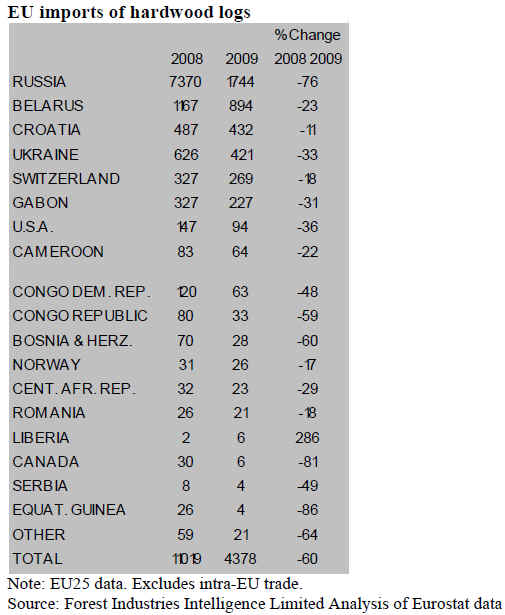
EU sawn imports down in 2009
The decline in EU imports of hardwood sawn lumber, at
around 37% in volume terms, was only slightly less
dramatic than that experienced in the log sector.
All supply countries fared badly in the European market
last year. The USA, the leading supplier, did better than
most - the 27% decline in EU imports from the USA was
relatively modest compared to the downturn in imports
from other countries. The relative weakness of the dollar
against the euro was one factor boosting U.S. hardwood
competitiveness in Europe during 2009.
During 2009, Cameroon retained its position as the leading
supplier of tropical hardwood sawnwood to the EU despite
a 36% decline in shipments compared to the previous year.
A number of factors contributed to this decline including:
very slow European consumption of the leading Cameroon
redwood species sapele and sipo; continuing efforts by
European importers to destock during the first half of
2009; and mounting supply problems in the second half of
the year.
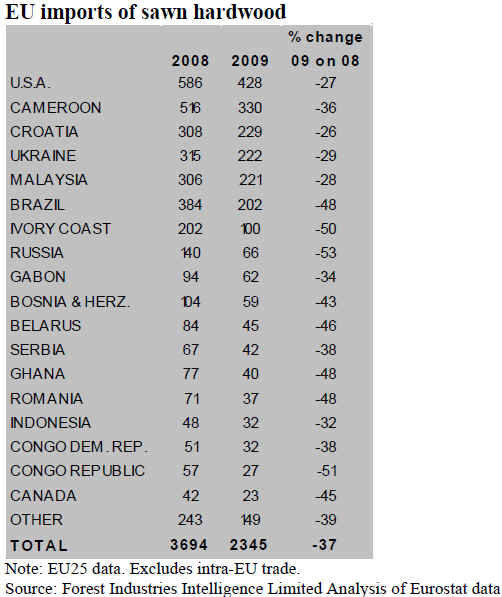
EU imports of sawnwood from Malaysia held up
marginally better than those from Cameroon, benefiting
partly from the weaker dollar (Malaysian hardwoods
unlike African hardwoods tend to be invoiced in dollars)
and also from better availability and faster turnaround
times. This latter factor has become particularly important
in the recession as distributors throughout the European
supply chain have been much less reluctant to carry stock.
Continuing supply problems and better market prospects at
home contributed to a dramatic 48% fall in EU imports of
hardwood sawn lumber from Brazil.
EU hardwood plywood imports down 28% in 2009
EU imports of hardwood plywood were down 28% in
volume terms during 2009. Imports from Russia, the
leading supplier of hardwood (mainly birch) plywood to
the EU, experienced only a relatively modest decline of
12%. Russian plywood producers stepped in to fill some
of the gap in Finnish supply with the phased introduction
of Russia¡¯s log export taxes. There are also reports that
more European plywood buyers are switching away from
tropical hardwood in favour of Russian birch product.
During 2009, China retained its dominant position as the
leading developing world supplier of hardwood plywood
to the EU, although at 530,000 cubic metres the volume is
only half of that attained in 2007.
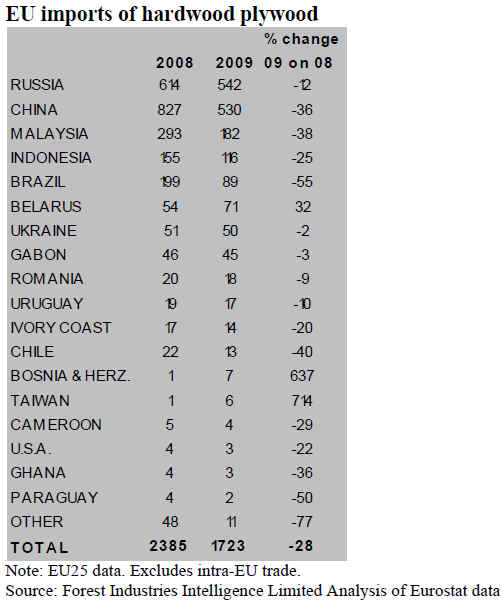
After significantly expanding share in the European
hardwood plywood market in 2008, Malaysia lost ground
in 2009. Recent trade reports suggest that declining
availability due to tightening log supply in Malaysia is
now encouraging more European importers to look to
alternatives, including Russian birch plywood, alternative
panels and non-wood products.
The pace of the long-term decline in European imports of
Indonesian plywood slowed in 2009. However imports of
Indonesian plywood ¨C which reached only 116,000 cubic
metres in 2009 - are a shadow of levels of around 600,000
cubic metres only 7 years ago. Meanwhile the decline in
European imports of Brazilian hardwood plywood
steepened last year, falling 55% to only 89,000 cubic
metres.
Changes underway in EU veneer sector
Europe¡¯s hardwood veneer import figures for 2009 bear
the imprint of differing trends affecting the rotary and
sliced veneer sectors. Both sectors have been profoundly
influenced by the global economic downturn.
The rotary veneer sector is being influenced both by
falling European consumption of tropical hardwood
plywood and by the continuing shift in tropical hardwood
plywood manufacturing away from Europe (notably
France). These trends are particularly apparent in the
significant decline over the last two years in European
veneer imports from Gabon, the leading supplier of rotary
veneer (mainly okoume), to the European market.
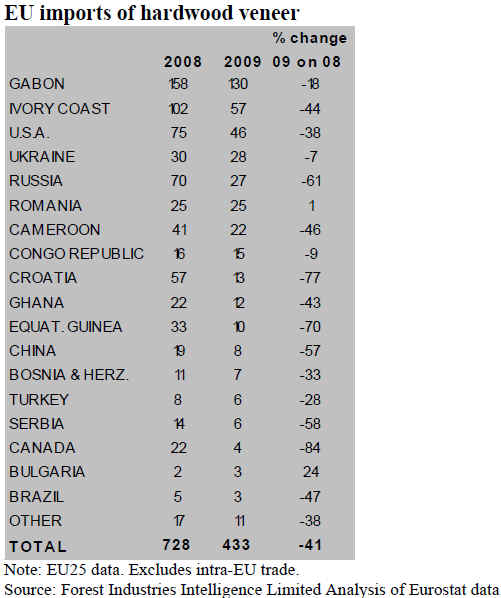
Meanwhile, the European sliced veneer sector experienced
a major crisis during 2009. There was a huge fall-off in
demand, particularly in the door sector in Spain which had
previously been one of the largest consumers of sliced
veneer in Europe. A major reduction in hardwood
harvesting in all the leading supply regions greatly
reduced access to veneer quality logs. Severe cash flow
problems also limited the ability of veneer mills to procure
those logs that were available. This all occurred at a time
when competitive pressure from the laminate and nonwood
surface materials sector ¨C also suffering from excess
capacity - was on the rise and as product manufacturers
were looking for ways to cut costs.
As a result of these trends, all the leading suppliers of
sliced veneer lost a lot of ground in the European market
during 2009. The volume of European hardwood veneer
imports from Ivory Coast, the U.S.A. and Cameroon was
down 44%, 38% and 46% respectively. For these
suppliers, some cold comfort may be found in the fact that
market conditions were just as bad for European veneer
manufacturers. The Germany-based trade journal EUWID
reports that large European veneer mills were operating at
no more than 50% to 70% of capacity throughout 2009.
Signs of recovery in EU imports
While the 2009 annual import data makes for very gloomy
reading, closer analysis of the quarterly data provides
grounds for optimism.
The chart below indicates that EU imports of hardwood
logs, sawn and veneer from developing countries all
turned upwards in the last quarter of 2009. In the case of
logs and sawn, this was the first upward movement in
import data following seven consecutive quarters of
decline.
For veneers, the upturn followed on from six consecutive
quarters of decline. Meanwhile, the upturn in EU imports
of plywood which began in the third quarter of 2009 was
maintained into the last quarter of the year.
The signs are more promising but there is still
considerably uncertainty over the likely strength of
recovery in European tropical wood imports during 2010.
Trade reports suggest that the recent rebound in imports
has less to do with any significant change in underlying
consumption than in a move by importers to fill gaps in
stocks which have become extremely thin on the ground
after such a long period low imports.
European imports of tropical hardwood logs from Gabon
also received a significant short-term boost in the final
quarter of 2009 as European plywood manufacturers
sought to build stocks in advance of Gabon¡¯s log export
ban scheduled to be introduced from 1 January 2010.
At the end of 2009, European importers of all hardwood
products were also responding to widespread reports of
tightening availability in major supply regions which was
widely reflected in rising prices. Lack of availability
combined with patchy consumption may well put a brake
on further significant increases in European imports of
tropical hardwoods during 2010.
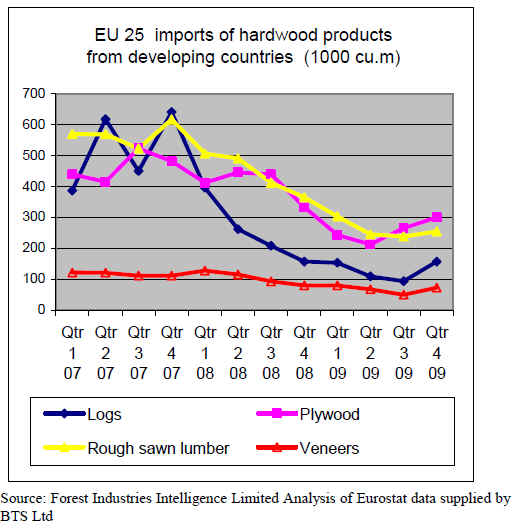
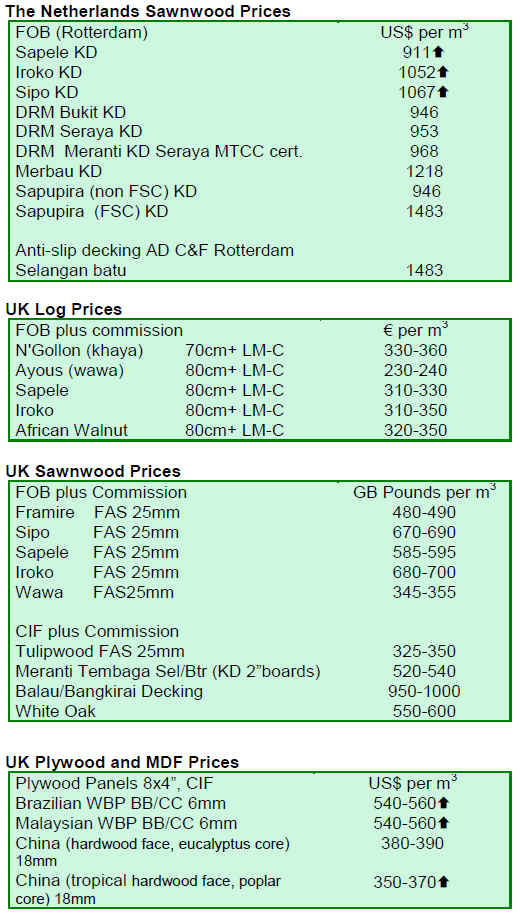
|